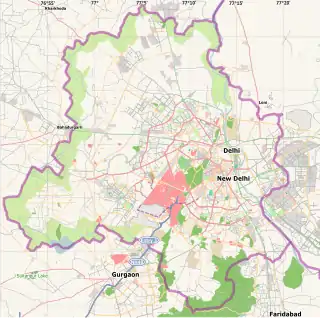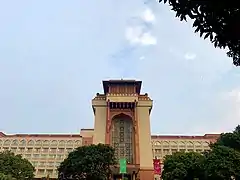Chanakyapuri
Chanakyapuri is a neighbourhood and diplomatic enclave established in the 1950s in New Delhi.[1][2][3] It is also a sub-division (tehsil) of New Delhi district. Chanakyapuri translates to the City of Chanakya and is named for the 3rd-century BC advisor and prime minister of the great Mauryan King Chandragupta Maurya.[4] It plays host to the majority of foreign embassies in New Delhi. Chanakyapuri was also developed as official residences for both politicians and civil servants of the Government of India. As such, it has numerous parks and open spaces, and suffers few utility disruptions. It is located near the Prime Minister's residence.
Chanakyapuri | |
|---|---|
Sub-Division | |
 Chanakyapuri Location in Delhi, India | |
| Coordinates: 28.59153°N 77.171895°E | |
| Country | |
| State | Delhi |
| District | New Delhi |
| Government | |
| • Body | New Delhi Municipal Council |
| • Member of Parliament | Meenakshi Lekhi |
| Area | |
| • Total | 6.085 km2 (2.349 sq mi) |
| Elevation | 236.67 m (776.48 ft) |
| Languages | |
| • Official | Hindi, English |
| Time zone | UTC+5:30 (IST) |
| PIN | 110021 |
| Lok Sabha constituency | New Delhi |
| Civic agency | NDMC |
History
Chanakyapuri was the first major extension of New Delhi beyond Lutyens' Delhi. The Central Public Works Department (CPWD) developed a large area of land acquired from ancient Gurjar village that was located there to create this diplomatic enclave in the 1950s. Subsequently, this land was allotted to embassies, chanceries, high commissions and ambassador residences. The enclave is built around a wide central vista, known as Shanti Path (Peace Road), with wide green areas. A large landscaped park spread over an area of 80 acres, known as Nehru Park, was developed in 1969 for the families of the diplomatic personnel. The ancient Bhairon Temple of relocated gurjar Baisoya village (in 1920s) Alipur stands by the park. In time, two markets, two colleges and schools run by diplomatic missions (including The British School and The American School) were established in the neighbourhood.[5]
Chanakyapuri, meaning city of "Chanakya", is named after Chanakya, a third-century BC Mauryan advisor and prime minister. Today Chanakyapuri is the diplomatic district of New Delhi, situated amidst a lush green expanse. It is characterized by wide avenues, landscaped round about, eclectic architecture, diplomatic missions, government housing, international schools and some of Delhi’s finest and oldest 5-star hotels. The diplomatic enclave is the residential districts within Chanakyapuri, a favourite residential option for diplomats, bureaucrats and affluent Indians. The area enjoys the best civic amenities in the city. The majority of the houses and apartments are around Malcha Marg and Rajdoot Marg which divide the crescents around which the plots are located. Thus every property looks into a park or a green belt. The plots vary from 375 Sqyds to 800 Sq.yds and offer a residential apartment in the range of 1600 Sq.ft to 3000 Sq.ft.
Accessibility
Major roads in Chanakyapuri include Shanti Path, Nyaya Marg, Niti Marg, Chandragupta Marg and Panchsheel Marg. In addition to these, the Ring Road traverses the southern expanse of the neighbourhood and intersects National Highway 8 on the border with neighbouring Dhaula Kuan. Sardar Patel Marg marks the Western periphery, while the Chanakya Cinema complex, which lies beyond Nehru Park, forms the south-western perimeter. The Delhi Ring Railway stops at Chanakyapuri, while Lok Kalyan Marg metro station and Jor Bagh metro station are the nearest stations of Delhi Metro.
Points of interest

There are various architectural delights in the area, including several embassies and hotels. Some of these are listed below:
- Akbar Bhawan in Chanakyapuri where South Asian University is currently functioning, this is India's International university established by SAARC nations, Akbar Bhawan is also the home of Ministry of Overseas Indian Affairs (MOIA) of the Government of India.
- The Ashok Hotel in Chanakyapuri hosts a yearly bazaar where many embassies present items from their countries for sale.
- The United States Embassy and Chancery were designed by Edward Durrell Stone in 1959.
- The Russian Embassy embodies Stalinist architectural principles. The British High Commission and German Embassy were constructed in similar styles during the 1950s. The Thai Embassy to is visually striking.
- The Polish Embassy is large and expensive—to an otherwise unusual degree—product of the over-optimistic Gierek era of the 1970s.
- The Belgian Embassy is a red brick structure designed by the renowned Indian artist Satish Gujral, as one of his only known architectural endeavors. It is located at the roundabout at the Rail Museum and dates to the mid-1970s.
Chanakyapuri is also home to the following:
- The National Rose Garden, open to the public in December and January.
- The National Rail Museum, which depicts the rail heritage of India.
- Nehru Park, established in 1969.
- The ancient Bhairon Temple.
- Navy Children School, Delhi, established in 1965.
- Carmel Convent.
- The Ravi Shankar Centre.
- Primus Super Speciality Hospital is an international hospital serving people from all over the world and Embassy diplomats.
- MEA Complex is a place where Indian Diplomats stay.
Chanakyapuri is also home to a number of hotels and other services catering to both foreign and (affluent) domestic visitors to Delhi. These include the Hotel Ashok, Hotel Samrat, the Maurya Sheraton, Taj Palace, Claridges, the Leela Palace and Diplomat, along with certain establishments by the Youth Hostels Association of India. Primus Group of hospitals also operates an International Hospital in this neighborhood, in western Chanakyapuri.
Education
Primary and secondary schools
- The American Embassy School, for expatriates from America and other countries.
- The British School offers the British National Curriculum, the IGCSE and IB. It primarily serving the international community.
- German School New Delhi[6]
- Russian Embassy School in Delhi[7]
- Sanskriti School, a renowned education institution, which mainly serves the children of civil servants.
- Navy Children School which mainly serves the children of Naval background.
Universities
- Jesus and Mary College, a constituent college of the University of Delhi.
- Maitreyi College, another constituent college of the University of Delhi.
- South Asian University, an International University established by SAARC countries.
- Ashok institute of hospitality and tourism management, IGNOU affiliated
See also
- Ministry of External Affairs of India
- Areas And Zones of New Delhi
- Lutyens' Delhi
References
- PTI (14 August 2015). "Dwarka diplomatic enclave to be modelled on Shanti Path". The Economic Times. Retrieved 1 July 2018.
- What Lies Inside Delhi's Diplomatic Enclaves?
- Delhi’s Belly - Secret republics
- Travel Delhi, India. MobileReference. 2007. ISBN 978-1-60501-051-9.
- Viswambhar Nath (2007). "Delhi Before 1947". Urbanization, urban development, and metropolitan cities in India. Concept Publishing Company. p. 248. ISBN 978-81-8069-412-7.
- "Contact." German School New Delhi. Retrieved on 11 February 2015. "2, Nyaya Marg, Chanakyapuri New Delhi 110 021 India" - Also listed as: "Block F, Diplomatic Enclave, Chanakyapuri"
- "Сведения о школе." (Archive). Russian Embassy School in New Delhi. Retrieved on 18 April 2015. "PLOT G BLOK 50E NYAYA MARG, CHANAKYAPURI, NEW-DELHI -110021, INDIA"